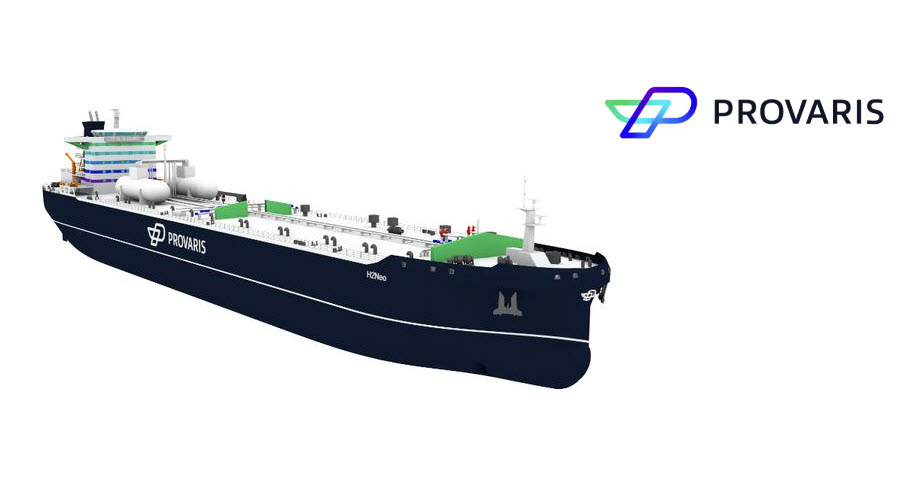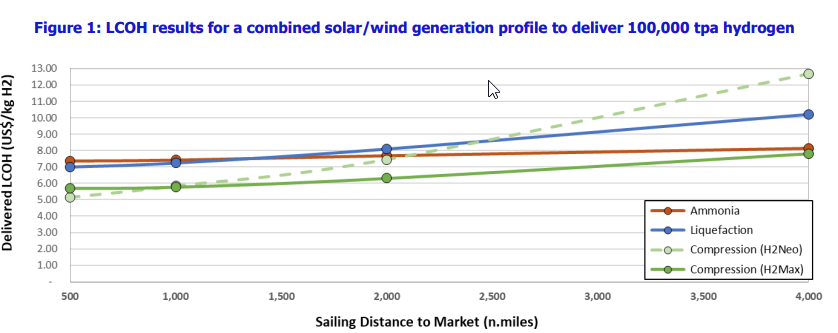
New Hydrogen Supply Chain Study Highlights Overwhelming Advantage for Marine Transport.
HIGHLIGHTS:
- Provaris’ latest report compares the delivery cost of hydrogen for three hydrogen energy vectors (compression, liquefaction, and ammonia) when integrated with a variable renewable energy profile to produce hydrogen.
- Energy use and losses across the entire supply chain (generation, production, and delivery) associated with liquefaction and ammonia exceed 40%, while compression remains below 20%.
- Compression is the most cost-effective option for regional transport distances from 500 to 4,000 nautical miles with volumes of up to 500,000 tonnes per annum (tpa).
- Liquefaction and ammonia suffer from high levels of renewable energy curtailment, energy use in the conversion process (20-30% loss), and energy use in the conversion back to gaseous hydrogen upon delivery (5-30% loss).
- Compression is the most compatible with variable renewable generation profiles as it can fully “load follow,” eliminating additional capex required for “battery and hydrogen storage” to manage variability.
- A bulk-scale hydrogen storage solution is required regardless of the hydrogen energy vector selected, and the recent launch of Provaris’ proprietary H2Leo floating storage solution is a low-cost alternative for hydrogen storage.
- Compression is a compelling solution for regional green hydrogen trade to support the REPowerEU requirement for 10Mtpa imports by 2030.
SYDNEY– Provaris Energy Ltd (Provaris or the Company) is excited to announce the successful completion of its 2023 Hydrogen Marine Transport Comparison Report (the Report). The findings of the Report further solidify the numerous advantages of the compressed storage and maritime transport hydrogen supply chain and highlight that compression is a viable alternative and low-cost delivery method for the regional transport of hydrogen.
Martin Carolan, Provaris Managing Director and CEO, commented: “We are witnessing a remarkable increase in awareness and comprehension of some of the formidable challenges associated with delivering green hydrogen and the need for scalable solutions before 2030. Relying predominantly on ammonia supply chains to deliver hydrogen is not necessarily an efficient solution for governments and industries that require gaseous hydrogen to achieve emission reduction targets. Given the urgency to take immediate action and expedite the development of supply chains, compression emerges as a key enabler that can unlock the potential of renewable resources and deliver substantial volumes to regional markets while maintaining favorable economic returns. In contrast, the liquefaction and ammonia alternatives present less favorable economics. By embracing compression as a crucial element in our hydrogen infrastructure, we ensure a swifter realization of emission targets for hard-to-abate sectors and effectively address the challenges we have ahead of us.”
Garry Triglavcanin, Provaris Chief Development Officer added: “A key objective of this Report was to understand and identify each of the components that together delivered the complete “generation, production and delivery” vector supply chain for marine transport as either compressed gas, liquefied, or ammonia, relying on renewable power generation.
One of the key outcomes of the Report confirms that hydrogen produced from a renewable energy resource and delivered by marine transport either required: i) a process such as compression that was suitable to “load follow” the variability of the renewable generation profile; or ii) for liquefaction and ammonia, to the installation of a significant level of “battery and hydrogen storage” capacity to enable the hydrogen to be export ready. The latter was found to have a significant impact on the cost of producing green hydrogen.”
Provaris has consistently emphasized the importance of understanding the overall efficiency of the complete hydrogen supply chain, from renewable electricity generation through to hydrogen production and delivery to the end customer. This Report precisely identifies the energy use and losses associated with each hydrogen energy vector (compression, liquefaction and ammonia) and the significant impact they have on the full delivered cost of hydrogen. Liquid Organic Hydrogen Carriers have not been considered in the comparison as they are considered only to be a viable alternative for specific production and use cases.

Read the most up to date Fuel Cell and Hydrogen Industry news at FuelCellsWorks




